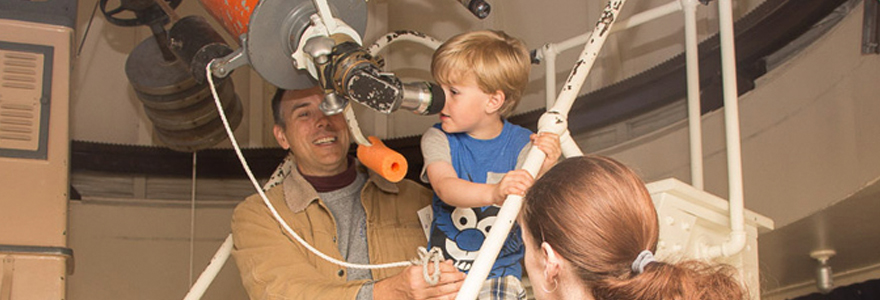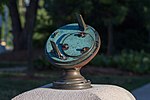Observatory Highlights
Observatory Highlights

Facilities
Building and Dome
The building is a stone structure, being 31 feet by 45 feet in horizontal dimension, made of Credit Valley Limestone, and trimmed with Indiana Sandstone. The building was designed by local architect O. Roy Moore, and built by the Putherbough Company. The dome was fabricated by Perkin-Elmer Corporation in New York, shipped in pieces, and assembled on site.
Telescopes
The 254 mm refractor
The brass refractor telescope, finders, German equatorial mount, and pier were purchased from Perkin-Elmer Corporation of New York for the sum of $7500 CDN. The objective is a crown and flint achromatic lens, the glass having been poured by Chance Brothers of England. The (then) U.S. firm Bausch and Lomb was first contracted to pour the glass for the objective lens, but because of the war effort was not able to fulfill its commitment. The best guess is that the lens was ground and polished by Halley Mogey (private family communication), the first employee of Perkin-Elmer Corporation and son of famed telescope maker William Mogey. The telescope tube is brass, having a focal length of 4386mm, which yields a speed of f/17.2. The telescope is fitted with 25mm and 90mm finders.
The 203 mm Schmidt camera
When the large refractor was shipped to Canada, Perkin-Elmer included the Schmidt camera at no extra charge, even though it was apparently not originally ordered. It is said that because of the war effort, Perkin-Elmer was shifting its focus to military contracts and hence stopped its production of retail telescopes. The telescope is a classic Schmidt camera, having a 203 mm diameter corrector plate, with a 300 mm diameter spherical mirror (an 8″/12″ design). A small sliding door in the side of the instrument allows the loading of a circular piece of photographic film, mounted in a film holder.
The provenance of this camera is not well known. We know that Perkin sent Halley Mogey as an apprentice to work with Don Hendrix at Mount Wilson Observatories. Hendrix was perhaps the best optician in the USA at that time. He had learned about Schmidt cameras from Walter Baade, and became an expert in this field. It is thus well possible that Mogey learned about Schmidt cameras from Hendrix, and then built the Cronyn Schmidt camera. There is however also a clear connection to James Gilbert Baker. Baker was a junior fellow at Harvard University at the time Perkin-Elmer was founded in 1937 (and incorporated in Dec. 1939), but was a consultant for Perkin-Elmer in 1940. In that year, he developed his own version of the camera, to be known as the Baker-Schmidt camera. He may well have had his hands on the Cronyn Schmidt camera while he was a junior, especially since he is known to have designed a Schmidt camera that is identical to the one at Cronyn. Possibly Mogey and Baker worked on our Schmidt camera together.
The 300 mm Cassegrain reflector
This telescope was purchased by William H. Wehlau in 1958 and was installed onto the refractor for the purpose of extending the photometric capabilities of the observatory. A new photometer was constructed and first deployed in 1960. The telescope has a 300 mm diameter parabolic mirror and has a focal length of 5232 mm, yielding a speed of f/17.2. The manufacturer of this instrument is not known, but the instrument is similar to those made by the J.W. Fecker company (who had taken over the famous John Brashear company of Pittsburg in 1926).
Gibbs Heliochronometer

In 1906 astronomer and engineer George James Gibbs applied for a patent for what he called a “Universal Equinoctial Mean Time Heliochronometer”, basically a fancy, more accurate sundial. In the same year he formed a partnership with Pilkington to sell the instrument as the Pilkington-Gibbs Heliochronometer. About 1,000 were made. The instrument at Western is stamped No. 953 and was likely resold by Negretti and Zambra. A cam device on the instrument takes into account the equation of time, thereby converting local solar time to within about a minute of mean solar time.
This instrument, along with a Ginkgo tree were presented to the university by the Arts Class of 1925, the first class to graduate from the newly finished University College building. The tree and heliochronometer were originally placed on the northeast lawn of University College. The heliochronometer was subsequently moved in front of Cronyn Observatory in 1952. After also being moved, the Ginkgo tree now thrives in its original location, turning a blazing yellow in about the first or second week of November.
Classroom
Building renovations of 1996 resulted in the replacement of the main floor foyer and two offices with a modern classroom that can seat approximately 70 people.
History rooms
For the celebration of the 75th anniversary in 2015, part of the basement of the observatory was converted into one 1940 historical period room and one science demonstration room. Since that time a 1967 Elginfield Observatory room as well as a William Colgrove historic workshop have been added. These are all open to the public during public events.
